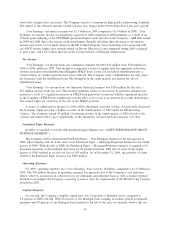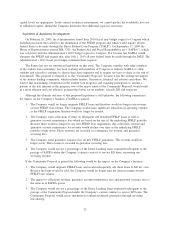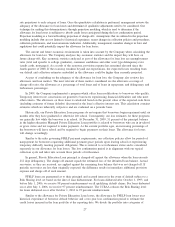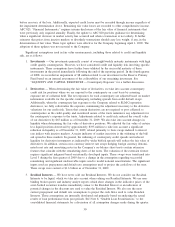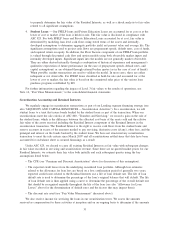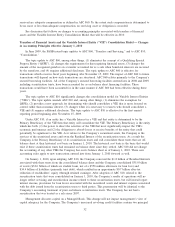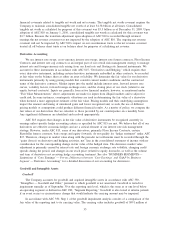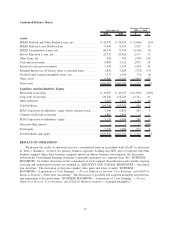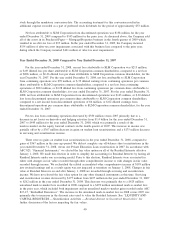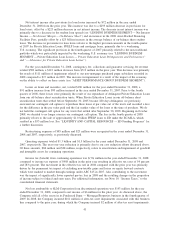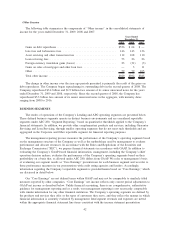Sallie Mae 2009 Annual Report Download - page 34
Download and view the complete annual report
Please find page 34 of the 2009 Sallie Mae annual report below. You can navigate through the pages in the report by either clicking on the pages listed below, or by using the keyword search tool below to find specific information within the annual report.financial covenants related to tangible net worth and net revenue. The tangible net worth covenant requires the
Company to maintain consolidated tangible net worth of at least $1.38 billion at all times. Consolidated
tangible net worth as calculated for purposes of this covenant was $3.5 billion as of December 31, 2009. Upon
adoption of ASC 810 on January 1, 2010, consolidated tangible net worth as calculated for this covenant was
$2.7 billion. Because the transition adjustment upon adoption of ASC 810 is recorded through retained
earnings the net revenue covenant was not impacted by the adoption of ASC 810. The ongoing net revenue
covenant will not be impacted by ASC 810’s impact on our securitization trusts as the net revenue covenant
treated all off balance sheet trusts as on balance sheet for purposes of calculating net revenue.
Derivative Accounting
We use interest rate swaps, cross-currency interest rate swaps, interest rate futures contracts, Floor Income
Contracts and interest rate cap contracts as an integral part of our overall risk management strategy to manage
interest rate and foreign currency risk arising from our fixed rate and floating rate financial instruments. We
account for these instruments in accordance with ASC 815, “Derivatives and Hedging,” which requires that
every derivative instrument, including certain derivative instruments embedded in other contracts, be recorded
at fair value on the balance sheet as either an asset or liability. We determine the fair value for our derivative
instruments primarily by using pricing models that consider current market conditions and the contractual
terms of the derivative contracts. Market inputs into the model include interest rates, forward interest rate
curves, volatility factors, forward foreign exchange rates, and the closing price of our stock (related to our
equity forward contracts). Inputs are generally from active financial markets; however, as mentioned under
“Fair Value Measurements” above, adjustments are made for inputs from illiquid markets and to adjust for
credit risk. In some instances, counterparty valuations are used in determining the fair value of a derivative
when deemed a more appropriate estimate of the fair value. Pricing models and their underlying assumptions
impact the amount and timing of unrealized gains and losses recognized and, as such, the use of different
pricing models or assumptions could produce different financial results. As a matter of policy, we compare the
fair values of our derivatives that we calculate to those provided by our counterparties on a monthly basis.
Any significant differences are identified and resolved appropriately.
ASC 815 requires that changes in the fair value of derivative instruments be recognized currently in
earnings unless specific hedge accounting criteria as specified by ASC 815 are met. We believe that all of our
derivatives are effective economic hedges and are a critical element of our interest rate risk management
strategy. However, under ASC 815, some of our derivatives, primarily Floor Income Contracts, certain
Eurodollar futures contracts, basis swaps and equity forwards, do not qualify for “hedge treatment” under ASC
815. Therefore, changes in market value along with the periodic net settlements must be recorded through the
“gains (losses) on derivative and hedging activities, net” line in the consolidated statement of income with no
consideration for the corresponding change in fair value of the hedged item. The derivative market value
adjustment is primarily caused by interest rate and foreign currency exchange rate volatility, changing credit
spreads during the period, and changes in our stock price (related to equity forwards), as well as the volume
and term of derivatives not receiving hedge accounting treatment. See also “BUSINESS SEGMENTS —
Limitations of ‘Core Earnings’ — Pre-tax Differences between ‘Core Earnings’ and GAAP by Business
Segment — Derivative Accounting” for a detailed discussion of our accounting for derivatives.
Goodwill and Intangible Assets
Goodwill
The Company accounts for goodwill and acquired intangible assets in accordance with ASC 350,
“Intangibles — Goodwill and Other,” pursuant to which goodwill is not amortized. Goodwill is tested for
impairment annually as of September 30 at the reporting unit level, which is the same as or one level below
an operating segment as defined in ASC 280, “Segment Reporting.” Goodwill is also tested at interim periods
if an event occurs or circumstances change that would indicate the carrying amount may be impaired.
In accordance with ASC 350, Step 1 of the goodwill impairment analysis consists of a comparison of the
fair value of the reporting unit to its carrying value. The carrying value includes goodwill of $991 million at
33



